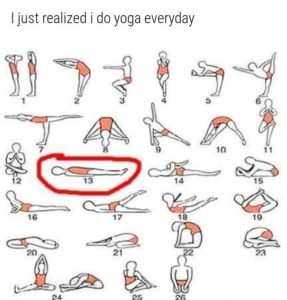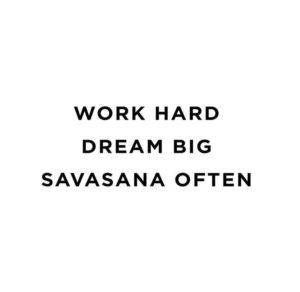We’ve all heard it before in our yoga classes: savasana is the most important pose.
Or we see it on yoga t-shirts: I’m just here for the savasana. Even people who don’t practice yoga seem to understand the central importance of this posture.
For as basic as savasana is, it’s also known as the hardest yoga pose. To say the least, this posture has a big reputation.
In this post, we’ll take a deeper dive into the reasoning for this posture, what’s happening inside of it, and why it’s simultaneously delightful and challenging. We’ll also explore how you can have a more powerful experience in savasana so that you can approach your next practice with inspiration and deeper knowledge.
What is Savasana?

Sava, in Sanskrit, means corpse. This is why we also call the posture Corpse Pose. The name of the posture certainly has to do with the way it looks, but it’s also a lot deeper than that.
The instruction to “do” this posture, is to do nothing. It is challenging to discuss Corpse Pose because there is really no beginning nor end to this posture. There are no alignment notes, no directions. Savasana simply is.
To be blunt: we “do” this posture by imitating the qualities of a corpse. We let go of all musculature engagement and physical control. We deeply relax, allowing our bodies to sink into the floor (almost like a burial). Ideally, we bring the mind to stillness — but we know that sounds a lot easier than it is. (More on this later.)
On the outside, the posture is as simple as it gets. And while it feels quite good to just splat on the ground after a solid practice — the symbolism of the posture is where we get most of its potency.
Why do we do Savasana?
Deepening our savasana begins by understanding the symbolism of the posture more intimately. It begins with the question: Why is this pose called “Corpse” Pose? Why must it reference death?
This is a posture of symbolism. And we can dissect this symbolism from various perspectives:
1. Savasana as the death of the Ego
Through the journey of asana, our physical postures, we make contact with awareness. We use the physicality of the practice to anchor the mind, and ground into the present moment. This happens naturally through practice, which is why we find ourselves yearning to return to the mat.
As we tap into this aware state, we are connecting to a place within ourselves where the ego cannot exist. We are in a space beyond ego, so to speak. So in that sense, our arrival at savasana is a pronunciation of ego death.
This is important to consider. Most of us tend to spend the high majority of our days protecting the ego — which leads us into all sorts of binds. To come to the yoga mat and experience ego death? Profound.
2. Savasana as preparation for death
Another way to look at it, perhaps more aligned with the teachings, is how we are imitating death in savasana. Not only does this pose teach us deep relaxation, but it is meant to also “prepare us for death.”
In various sacred texts, it is explained that our state of being upon the moment of our death has an influence on our future incarnations. So in this sense, savasana prepares us for a very peaceful, blissful death — we practice our “final resting pose.”
3. Savasana as an ending and a beginning
Just pondering this posture in itself, and the way it concludes a journey of sorts on the yoga mat is brilliantly symbolic. Throughout our practice, we experience ups, downs, peaks, valleys, discomfort, and pure joy — very similar to life. Typically we aren’t the same person after the practice as before, and savasana represents the “death” of the old Self.
In reality, we are never the same person as we were the day before. Continual experience and the evolutionary laws of nature (we are a part of nature) guarantee that. In this sense, we can look at savasana as a celebration of our constant growth.
The benefits of Savasana

In addition to the powerful philosophies behind savasana, there are many health benefits to consider.
When we move into savasana, we are directed to take total stillness in the body. We are instructed toward deep relaxation. And this process requires a step away from the tension that we normally store in our bodies.
We find that the anchoring quality of the physical postures, asana, combined with the relaxation element of savasana, also deeply soothes the mind. We often experience a total release of mental strain — which may be completely inaccessible for you elsewhere.
As we release this mental strain, the nervous system is able to shift into the parasympathetic state. It is in this state that the body can begin restoring the systems that have been neglected due to stress.
This means that we can restore balance to the digestive system, immune system, hormone levels, and circulation. All of these systems are under fire when stress is present, even at low levels, so it’s fantastic to actually give the body this time to heal.
When else in your life are you able to lie still, and enjoy the feeling of being in a body? When else are you able to relax, for the sake of relaxing? The benefits of giving yourself this experience extend into the mental realm as well. Time spent in savasana decreases stress levels and anxiety and can make a significant positive impact on depression and other mental states.
What you experience in Savasana
As you might imagine, there are infinite answers to this. But it brings up an important consideration:
There is no way to do savasana right, wrong, better, or worse. All experiences in savasana are perfect.
So — you’re lying there completely incapable of not thinking? Perfect. You’re lying there, completely blissed out, traversing the astral plane? Also perfect.
Your ability to detach from the outcome and quality experience of your savasana is directly related to your experience of deeper relaxation. The mind does not like this, but you cannot “try” to relax. You can only relax. The more you try to do it, the farther you get.
It’s a strange paradox. But this is exactly the kind of exercise that we need to put ourselves through in this crazy, overstimulated modern world. We need to practice doing nothing and letting go. Because as it stands — we’re not so good at it.
Think of your experience in savasana like taking your hands off the wheel. Whatever happens, happens. We just need to practice love and gratitude for all outcomes.
It is normal (and beautiful) in savasana to:
- Feel tingling and pulsing sensations throughout the body
- See bright colors, textures, and shapes
- Venture into the dream state, perhaps even snore (let it happen)
- Experience intense emotions (let them move through to the best of your ability)
- Twitch
- Experience temperature shifts
- Feel angry, irritable, judgmental, and stressed
- Receive deep and wise insights about yourself, the world, the universe
- Feel a slight separation from the body, like you’re floating
There are so many more experiences that you could and will have; the sky’s the limit. The most important part: do not expect to experience any of this.
If you expect to see colors, you will either A) never see colors again; or B) see colors that your thinking-brain has done a great job of producing for you (an illusion of sorts) — but say goodbye to relaxation.
Just because you see colors, doesn’t mean you did a good job in savasana. Because remember, there’s no such thing. And next time you lie down for savasana, ditch the expectations that it should be anything like the last time.
Every time you lie back in savasana, you have an infinity of possibility taking over your experience. If you expect something, anything, to happen — you’ve taken away infinity and stepped into the narrow perspective of your mind. Approach savasana with the willingness to let go, and receive whatever experience is seeking you.
How to deepen your Savasana
So, you want to experience deeper savasana? It’s totally valid to crave a blissful Corpse Pose. We all want to experience that delightful space beyond time, stress, thoughts, etc.
No one can do your savasana for you. But we can give you some steps that may set you up for a more enjoyable savasana. These are fundamentals of practice that you can follow — but know that at some point, the practice will require you to let go.
So, here we go… You’re about to lie back into savasana to close your practice… Take these steps into consideration:
- As you lie back, take a moment to make your body extremely comfortable. Adjust as needed. Use prop support if needed. We never take a moment to really indulge in our physical comfort; now’s your chance.
- Reach stillness. Know that your savasana may not feel perfect, it just needs to feel sustainable to hold for a bit. Allow yourself to really be still. Do not look at your watch, keep your eyes closed, and do your best to (reasonably) keep your body still.
- Find deeper body awareness. As you begin the posture, start to become aware of your body as one, complete whole. Stretch your awareness down from the top of your head to the tips of your toes. Notice what it feels like to be aware of your entire body: what are the sensations?
- Notice the breath for a moment, as it is. Do not control the breath. Just watch the breath. Observe the body breathe itself.
- Notice the moment. The qualities which make this moment entirely unique.
- Feel your relaxation, deepen into your relaxation, and let go. Take your hands off the wheel.
- As thoughts and emotions inevitably surface, reroute your attention back to your body, breath, and/or the moment. Take your awareness to the moment and the information inside of it.
Savasana is an inner journey, and it can only be guided by you. The inner terrain is something that is entirely yours. You are the pioneer, the teacher, and the guide.
Know that it is completely normal to feel like you have no idea what you’re doing in savasana. The inner landscape is unknown — we were never taught this information. It’s also a world that you must explore through direct experience, you cannot conceptualize it. You must do the practice to gain understanding. And you can’t think your way into it, either.

Savasana and life: The larger picture
Why is savasana so hard? Because within the stillness of our body, we often see how busy our mind truly is. It can be disconcerting. It can be incredibly vulnerable and uncomfortable, especially when emotions start lifting to the surface.
The point is to show up to your savasana, your stillness, regardless of the discomfort. And find peace and stillness anyway. This skill is invaluable.
In Corpse Pose, you practice staying present. You practice shifting awareness off of thought and into the present moment. And this shifting, often back and forth, strengthens our “presence muscle.” And you bet this helps us off the mat, too.
It’s the same muscle. After some committed practice, you will notice that the way you show up and endure your life is no different than the way you show up to savasana. There are so many parallels.
What it’s time to realize is that your stillness practice has the potential to revolutionize your life. And if you already have a strong approach to savasana, consider that there is so much more to yet experience.
When you gift yourself five minutes of savasana, it indicates your willingness to show up… For yourself. For all of the reasons already explored in this post. That you find yourself in savasana regularly is a REALLY BIG DEAL. Feel some gratitude for that.
It also brings us to our last point…
Why are you skipping Savasana?
Just wondering… What’s more important than you experiencing your own deep inner peace, which will ripple out into the rest of your life and inspire kindly the people you love most?
We get it, it happens sometimes that you have to scoot. But if this is your regular thing, if you’re thinking you don’t need it, then we lovingly say B.S. 🙂 Stop skipping savasana.
Whatever discomfort you’re avoiding there will find you in your life off the mat. And we know, it’s scary. We’re here to help you navigate through those waters.
In conclusion: Savasana is a practice
Your Savasana journey is a practice as much as your handstand. There are ups and downs. Steps back and steps forward. The only thing that matters is you showing up to it, with discipline and compassion for the fact that it isn’t easy.
If you’d like to up-level your practice, I would suggest seeking out some guided meditations. These kinds of experiences are really no different than savasana, you just have a guiding voice to take you deeper into your subtle body.
We have free Yoga Nidra over on the blog of our sister studio, Oasis. You can check out one of those Yoga Nidra practices here.
Feel free to post any follow-up questions or comments below! We hope this helped you make some new space in your savasana practice.

Devon Barrow is a yoga teacher for Ohana Yoga + Barre, our amazing social media manager, and a talented teacher for the YTT program. Yoga has been a part of Devon’s life since she was nine years old and continues to be her agent of healing and health. You’ll find both creativity of the physical body and the power of mindfulness in her classes.